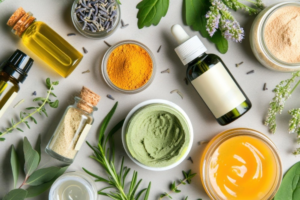In the realm of skincare, the term “combination skin” refers to a unique skin type characterized by having both oily and dry areas. Individuals with combination skin often find themselves struggling to strike the right balance between managing excess oil production in certain areas while combatting dryness in others. This can make finding an effective skincare routine quite challenging. However, with the right approach and products tailored to address specific needs, achieving balanced and radiant skin is entirely possible.
Table of Contents
Understanding Combination Skin
Before delving into the intricacies of a combination skincare routine, it’s crucial to understand what exactly constitutes combination skin. This skin type typically features oily patches, usually in the T-zone (forehead, nose, and chin), while other areas such as the cheeks may tend to be dry or normal. The key challenge lies in managing these disparate conditions simultaneously, requiring a targeted approach to address each concern effectively.

Benefits of a Combination Skincare Routine
1. Achieving Balance
One of the primary benefits of adopting a combination skincare routine is the ability to achieve balance across different areas of the skin. Combination skin is characterized by both oily and dry patches, making it challenging to find products that cater to both needs simultaneously. However, by implementing a tailored routine, individuals can effectively balance oil production in the T-zone while providing adequate hydration to dry areas, resulting in a more harmonious complexion overall.
By incorporating products specifically formulated for combination skin, such as gentle cleansers, lightweight moisturizers, and targeted treatments, individuals can rebalance the skin’s pH levels, regulate sebum production, and restore moisture where needed. This balanced approach helps prevent excess oiliness in certain areas while preventing dryness and flakiness in others, leading to smoother, more even-looking skin.
2. Addressing Multiple Concerns
Another significant benefit of a combination skincare routine is its ability to address multiple skincare concerns simultaneously. Unlike other skin types that may have a singular focus, combination skin requires a multifaceted approach to cater to its diverse needs effectively.
With a combination skincare routine, individuals can target various concerns such as excess oiliness, acne, dryness, and sensitivity, all within the same regimen. By incorporating a range of products with different active ingredients and formulations, individuals can address specific issues while maintaining overall skin health.
Identifying Your Skin Type
Before diving into a skincare routine, it’s crucial to identify your skin type to ensure you’re using products that cater to its specific needs. Understanding your skin type allows you to select the right products and treatments that will effectively address your concerns and promote overall skin health. Here are some key steps to help you identify your skin type:
1. Oberve Your Skin’s Texture
First, take a close look at your skin. Is it mostly smooth or rough? If your skin is oily, it’ll likely feel slick or greasy. Dry skin, on the other hand, might feel tight, flaky, or bumpy. And if you have combination skin, you’ll probably notice both oily and dry patches – with the T-zone being the oilier area compared to your cheeks.
2. Assess Your Skin’s Moisture Levels
Keep an eye on how your skin feels throughout the day. Does it feel tight and parched, especially after washing? Or does it get shiny and slick within hours? Dry skin usually lacks hydration and can feel tight or uneasy, especially after cleansing. On the flip side, oily skin tends to produce too much oil, resulting in a shiny or greasy look, particularly in the forehead, nose, and chin area.
3. Consider Your Pore Size
Take note of the size of your pores, particularly in the T-zone area. Oily skin is often characterized by larger, more visible pores, especially on the nose and cheeks, due to increased sebum production. Dry skin, on the other hand, may have smaller, less prominent pores.
4. Evaluate Your Skin’s Sensitivity
Figure out if your skin is sensitive or easily irritated. Sensitive skin may get red, itchy, or sting from certain products or environmental factors. Oily and mixed skin types tend to be more prone to acne and breakouts, while dry skin can get flaky or tight, especially in harsh weather.
5. Seek Professional Advice
If you’re still unsure about your skin type or have specific concerns, consider seeking advice from a dermatologist or skincare professional. They can perform a thorough analysis of your skin and recommend personalized products and treatments tailored to your individual needs.
Customizing Your Combination Skincare Routine

Crafting a personalized skincare routine tailored to combination skin is essential for achieving balance and addressing specific concerns effectively. By selecting the right products and treatments, you can manage oiliness in the T-zone while providing hydration to dry areas. Here’s how you can customize your combination skincare routine:
1. Cleansing
Start off your skincare routine with a mild cleanser that gets rid of grime, oil, and other impurities without drying out your skin. Go for a cleanser made especially for combination skin, one that has ingredients like salicylic acid or glycolic acid to clear out clogged pores and manage excess oil in the T-zone area. Gently massage the cleanser onto your damp skin using circular motions, then rinse it all off with lukewarm water.
2. Toning
After cleansing, use a balancing toner to help bring your skin’s pH back into a healthy range and visibly reduce the look of your pores. Go for a toner with soothing ingredients like witch hazel or rose water to calm and refresh your complexion. Steer clear of toners with alcohol, as they can be too drying for combination skin types. Apply the toner to a cotton pad and gently sweep it over your face, focusing on the T-zone and other oily areas.
3. Moisturizing
For combination skin, it’s crucial to keep things balanced through hydration. Go for a lightweight, oil-free moisturizer that can quench your skin’s needs without clogging pores or making oily areas even oilier. Ingredients like hyaluronic acid or glycerin are great for drawing in and locking in that much-needed moisture. When applying the moisturizer, spread it evenly over your face and neck, focusing a bit more on the dry spots while being careful not to overdo it on the oily zones.
4. Treating Specific Concerns
Incorporate targeted treatments into your routine to address specific concerns such as acne, dryness, or uneven texture. For oily areas prone to breakouts, consider using a mattifying serum or spot treatment containing ingredients like niacinamide or tea tree oil to control excess oil production and minimize blemishes. For dry patches, opt for hydrating masks or treatments enriched with ingredients like shea butter or ceramides to nourish and repair the skin barrier. Additionally, exfoliate regularly with a gentle chemical exfoliant containing ingredients like alpha hydroxy acids (AHAs) or beta hydroxy acids (BHAs) to remove dead skin cells and promote cell turnover, revealing smoother, more radiant skin.
Recommended Ingredients for Combination Skin
When it comes to caring for combination skin, choosing the right stuff is key to finding that sweet spot and tackling your specific issues effectively. Here are some top-notch ingredients that are especially great for combination skin:
1. Hyaluronic Acid
Hyaluronic acid is a total rockstar when it comes to skincare. It’s the perfect fit for combination skin because it can hydrate without leaving you feeling greasy. This magical ingredient plumps things up and smooths out wrinkles and fine lines, so your skin stays looking fresh and healthy.
2. Niacinamide
Niacinamide, also called vitamin B3, is super helpful for combination skin. It keeps oil production in check, especially in the T-zone area. Plus, it has anti-inflammatory properties that can soothe redness and irritation, making it great for sensitive spots. Niacinamide also strengthens the skin’s protective barrier, locking in moisture and giving you a glowy, healthy-looking complexion overall.
3. Salicylic Acid
Salicylic acid is a super-powered ingredient that can really get into your pores and scrub them clean. It’s awesome for combination skin that tends to get acne and clogged pores in the T-zone. This stuff helps unclog those pesky pores, cut down on extra oil, and stop breakouts before they start, so it’s a must-have for keeping your skin looking fresh and blemish-free.
4. Retinol
Retinol, which is a type of vitamin A, is a powerhouse ingredient that’s known to have anti-aging benefits. It helps boost collagen production, diminish the look of fine lines and wrinkles, and generally improve the overall texture and tone of the skin. Retinol is a great option for combination skin since it can address a variety of issues at once, like oiliness, dryness, and signs of aging. But it’s important to start with a low concentration and build up slowly to avoid any irritation, especially in more sensitive areas.
Morning Skincare Routine for Combination Skin

When caring for combination skin in the morning, the focus should be on thoroughly cleansing, providing adequate hydration, and shielding the skin from external stressors. Here’s a simple yet effective morning routine:
- Cleansing: Start your day by cleansing your skin with a gentle cleanser formulated for combination skin. Look for a product that effectively removes impurities and excess oil without stripping the skin of its natural moisture. Massage the cleanser onto damp skin, then rinse thoroughly with lukewarm water and pat dry.
- Toning: Follow cleansing with a balancing toner to restore the skin’s pH levels and prepare it for subsequent skincare products. Pick a toner with soothing ingredients like witch hazel or rose water to refresh your skin and reduce the look of pores. Dab the toner onto a cotton ball and gently wipe it over your face, concentrating on the T-zone and other oily areas.
- Serum: Apply a lightweight serum containing beneficial ingredients such as hyaluronic acid or niacinamide to hydrate and nourish the skin. These ingredients help maintain moisture balance, improve skin texture, and reduce the appearance of fine lines and wrinkles. Gently massage the serum onto your face and neck, allowing it to absorb fully before proceeding to the next step.
- Moisturizer: Follow up with a moisturizer suited to combination skin that provides hydration without clogging pores. Opt for a lightweight, oil-free formula that absorbs quickly and leaves the skin feeling soft and supple. Apply the moisturizer evenly to your face and neck, focusing on dry areas while avoiding over-application in oily regions.
- Sunscreen: Finish your morning routine with a broad-spectrum sunscreen to protect your skin from harmful UV rays. Choose a lightweight, non-comedogenic formula with an SPF of at least 30 and apply it generously to your face, neck, and any exposed areas. Reapply sunscreen throughout the day, especially if you’ll be spending extended periods outdoors.
Evening Skincare Routine for Combination Skin

For nighttime skincare, folks with combination skin should focus on thoroughly cleansing, using targeted treatments, and keeping the skin hydrated to repair and replenish it as you snooze. Here’s a suggested evening routine to try:
- Double Cleansing: To start your evening skincare routine, do a double cleanse. First, use an oil-based cleanser to break down and remove makeup, sunscreen, and any other grime that built up throughout the day. Then, follow up with a water-based cleanser to give your skin a thorough clean.
- Exfoliation (Optional): If using an exfoliant, apply it after cleansing to remove dead skin cells and promote cell turnover. Choose a gentle chemical exfoliant containing ingredients like glycolic acid or salicylic acid to unclog pores and improve skin texture. Use the exfoliant according to the product instructions, avoiding the delicate eye area.
- Toning: After exfoliating, use a gentle toner to restore your skin’s pH balance and get it ready for the next steps. Try a toner with calming ingredients like witch hazel or chamomile to soothe and refresh your complexion. Just apply it to a cotton pad and gently wipe it across your face, being careful around your eyes.
- Treatment: Use specific products targeted at your skin’s needs, like acne or wrinkles. Look for ingredients like retinol, niacinamide, or vitamin C to help renew your skin, even out your complexion, and minimize fine lines. Gently rub the product onto your face and neck, focusing on the problem areas.
- Moisturizer: End your day with a soothing moisturizer to keep your skin hydrated and refreshed through the night. Select a rich, emollient formula that provides long-lasting hydration and helps repair the skin barrier. Massage the moisturizer evenly onto your face and neck, using gentle upward motions to promote absorption.
- Eye Cream: Optionally, apply an eye cream to the delicate skin around the eyes to hydrate, brighten, and reduce the appearance of fine lines and wrinkles. Choose an eye cream specifically formulated for your concerns, such as dark circles, puffiness, or crow’s feet. Gently pat the eye cream onto the under-eye area using your ring finger, avoiding direct contact with the eyes.
Diet and Lifestyle Tips for Combination Skin
Your skin’s health depends on more than just skincare products. What you eat and how you live also greatly impact managing combination skin and keeping your complexion glowing. Here are some diet and lifestyle tips to help you achieve that balanced, radiant look.
1. Stay Hydrated

Make sure to guzzle down plenty of water throughout the day – this will keep your skin hydrated and healthy from the inside out. Staying well-hydrated helps maintain your skin’s elasticity and plumpness, which can minimise the look of fine lines and wrinkles.
2. Eat A Balanced Diet

Eat a well-rounded diet full of fruits, veggies, lean proteins, and good fats to nourish your skin. Make sure to include foods rich in omega-3s, like salmon, walnuts, and flaxseeds, which help keep your skin barrier strong and fight inflammation.
3. Limit Sugar And Processed Foods
Minimize your intake of sugary and processed foods, as they can contribute to inflammation and exacerbate skin concerns such as acne and oiliness. Opt for whole, nutrient-dense foods instead to support clear, radiant skin.
4. Manage Stress
Chronic stress can negatively impact skin health by triggering inflammation and exacerbating skin conditions like acne and eczema. Practice stress-reducing techniques such as meditation, deep breathing exercises, or yoga to promote relaxation and support skin wellness.
5. protect your skin from the sun
Make sure to protect your skin from the sun’s harmful rays by applying sunscreen every day, even when it’s cloudy. Go for a broad-spectrum sunscreen with at least SPF 30 and don’t forget to reapply it every couple of hours, especially if you’ll be spending a lot of time outside.
6. Get adequate sleep

Get plenty of high-quality rest each night, around 7-9 hours, so your skin can do its thing and repair and renew itself. If you don’t get enough sleep, your skin can start looking dull and worn out, and any existing issues could get worse. Make sure to set a consistent sleep schedule and develop a relaxing bedtime routine to help you get that sweet, restorative sleep.
7. Avoid smoking and excessive alcohol consumption
Smoking and drinking too much can mess up your skin, causing it to age faster, look dull, and get dried out. The best thing to do is quit smoking and cut back on alcohol to keep your skin looking healthy and glowing from the inside out.
Following these diet and lifestyle tips as part of your daily routine can help keep your combination skin healthy and looking great. Consistency is important, and even small changes can make a big difference over time. By taking care of yourself from the inside out and developing healthy habits, you can achieve a radiant, glowing complexion that shows how well you’re doing overall.
Avoiding Common Mistakes
When tending to combination skin, it’s crucial to dodge common blunders that can worsen current issues or throw off the skin’s equilibrium. Here are some traps to sidestep:
1. Over cleansing
While cleansing is crucial for removing dirt, oil, and impurities, over-cleansing can strip the skin of its natural oils and lead to increased dryness or oiliness. Stick to gentle cleansers and limit washing your face to twice a day, preferably in the morning and evening.
2. Skipping moisturizer
While some individuals with combination skin may avoid moisturizer altogether, fearing it will make their skin feel greasy, this approach can actually backfire. Skipping moisturizer can exacerbate dryness and lead to increased oil production in the long term. Instead, it’s advisable to opt for lightweight, oil-free moisturizers specifically formulated for combination skin. These products can provide essential hydration without clogging pores, helping to maintain a balanced and healthy complexion.
3. Using harsh exfoliants

Exfoliating your skin can be helpful for getting rid of dead cells and keeping your skin looking fresh. But going overboard with rough scrubs or exfoliating too much can actually end up irritating your skin and messing with its natural protective barrier. Instead, try using gentle chemical exfoliants with stuff like glycolic acid or salicylic acid – that way, you can get the benefits without causing any irritation or stripping your skin.
4. Ignoring sun protection
Failing to protect your skin from the sun’s harmful UV rays can lead to premature aging, sun damage, and an increased risk of skin cancer. Always wear sunscreen with an SPF of 30 or higher, even on cloudy days, and reapply regularly, especially if you’ll be spending time outdoors.
5. Using products not suited to your skin
Using skincare products that are too harsh or not suited to your skin type can exacerbate existing concerns and disrupt the skin’s balance. Choose products specifically formulated for combination skin, and pay attention to how your skin responds to different ingredients to tailor your routine accordingly.
6. Skipping patch tests
It’s super important to do a patch test with any new skincare products, especially if your skin is sensitive or tends to react easily. Just dab a tiny bit on an inconspicuous spot and give it a day or two to see if there’s any funky stuff happening before slathering it all over your face.
Seeking Professional Advice for Combination Skin
While establishing a skincare routine at home is essential for managing combination skin, seeking professional advice can provide valuable insights and guidance tailored to your individual needs. Here are some reasons why consulting a dermatologist or skincare professional can be beneficial for those with combination skin:
1. Expert assessment
A dermatologist or skincare professional can conduct a thorough assessment of your skin, including its type, concerns, and specific needs. They can identify any underlying issues, such as acne, rosacea, or eczema, and recommend appropriate treatments and products accordingly.
2. Personalized recommendations
Based on your skin assessment, a professional can provide personalized recommendations for skincare products and treatments that address your combination skin’s unique needs. They can recommend specific ingredients, formulations, and routines tailored to achieve optimal results.
3. Treatment options
Professionals can offer a range of treatment options for managing combination skin concerns, including in-office procedures such as chemical peels, microdermabrasion, or laser therapy. These treatments can help address specific issues like acne, hyperpigmentation, or uneven texture more effectively than at-home remedies alone.
4. Monitoring progress
Regular visits to a dermatologist or skincare professional allow for ongoing monitoring of your skin’s progress and adjustments to your skincare routine as needed. They can track changes in your skin’s condition, recommend modifications to your routine, and address any new concerns that may arise over time.
5. Addressing Complex Issues:
If you’re dealing with complex skin issues or multiple concerns beyond just combination skin, a professional can provide comprehensive care and guidance. They can diagnose underlying conditions, prescribe medications if necessary, and develop a holistic treatment plan to address all aspects of your skin health.
Staying Consistent for Combination Skin

Consistency is key when it comes to managing combination skin and maintaining a healthy, radiant complexion. Keeping up with your skincare routine can be a breeze with these handy tips:
1. Establish a routine
Make a skincare routine that fits your combination skin type. Include steps like cleansing, toning, moisturizing, and using targeted treatments. Pick products that match your skin’s needs, and use them regularly in the morning and night.
2. Stick to a schedule
Try to stick to a regular skincare routine and do it at the same time each day. That way, it’ll become a healthy habit, and you won’t forget or skip any steps.
3. Be patient
Hang in there, sticking to your skincare routine takes time, but it’ll pay off. Even if you don’t see results right away, keep at it – over time, those consistent habits will gradually improve your skin’s look and feel.
4. Listen to your skin
Pay attention to how your skin responds to different products and treatments, and adjust your routine accordingly. If you notice any signs of irritation or sensitivity, scale back on product usage or switch to gentler formulations.
5. Adapt as needed
Keep updating your skincare routine as your skin’s needs change over time. Check in on your regimen regularly, especially when seasons shift or your lifestyle alters, and tweak it as necessary to address new issues or maximize outcomes.
In conclusion, achieving balanced, radiant skin with combination skin demands a personalized approach. By selecting suitable products, embracing healthy lifestyle habits, and seeking professional guidance when needed, you can effectively manage your skin’s unique needs. Consistency is paramount; adhering to a tailored skincare routine and making mindful choices fosters optimal results. With dedication and a commitment to self-care, you can navigate the complexities of combination skin and unveil a luminous complexion. Embrace the journey, prioritize skincare, and celebrate the beauty of balanced, healthy skin.




